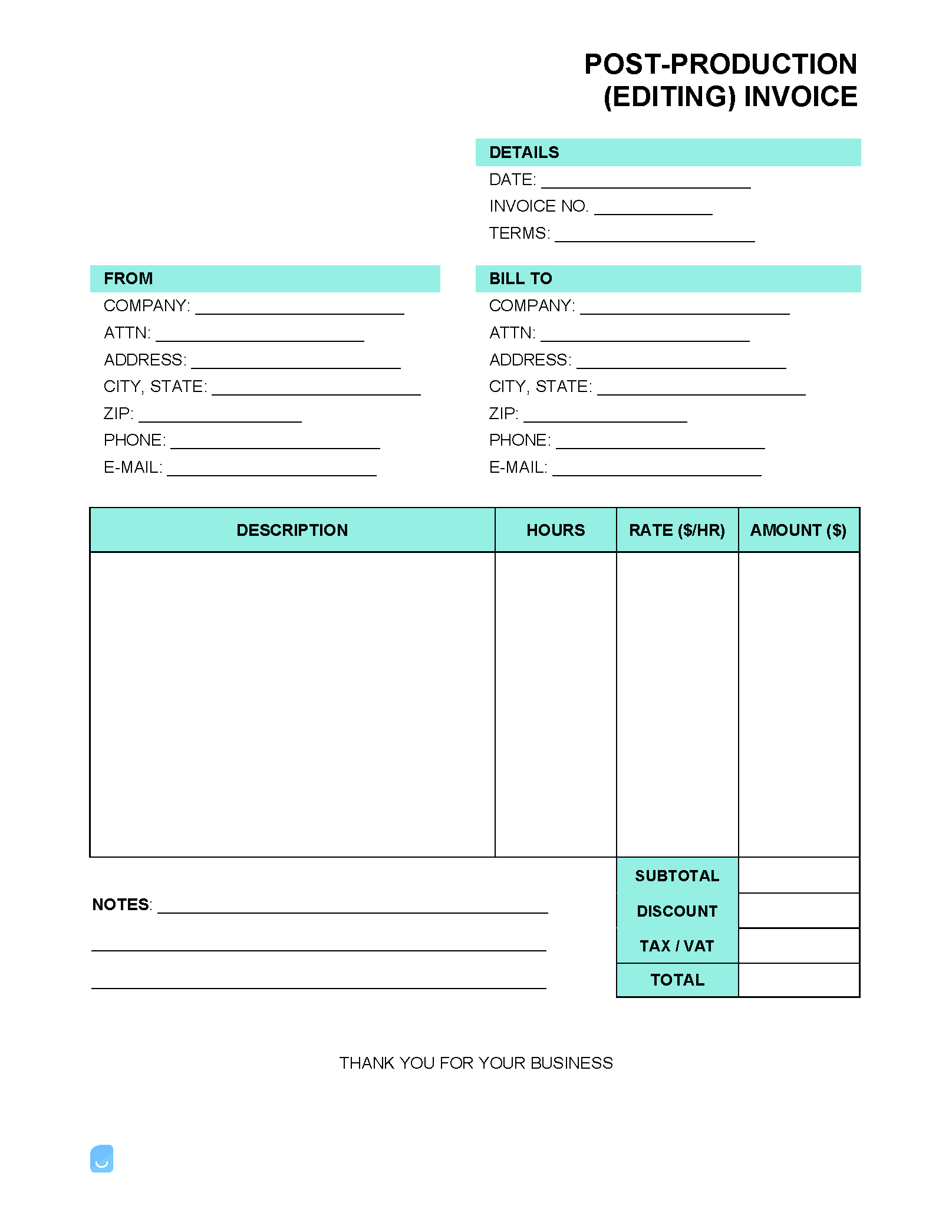Post-Production (Editing) Invoice Template
A post-production invoice contains detailed line items describing the individual charges and costs accrued during the editing of a film, song, or other creative production. Post-production can easily be the most expensive and labor-intensive part of the entire film-making or recording process; using an invoice that allows for a descriptive breakdown is essential for giving the client a clear picture of what was charged and why.

How to Create a Post-Production (Editing) Invoice That Gets You Paid
The post-production (editing) invoice is a document that is issued by the post-production company to the client, detailing the charges for the services rendered. The invoice should itemize the charges for each service rendered, as well as the total amount due.
What is Post-Production?
Post-production is a process completed by freelance editors and production companies for creative industries such as filmmaking, photography, and music. It follows the initial filming or recording process. Post-production is the process of taking a completed film or video and editing it into a final product. This can involve adding special effects, music, and other elements to create the desired look and feel of the finished work. Post-production is often considered to be the most important part of the filmmaking process. In the film industry, for instance, post-production includes stitching scenes together, editing dialogue, mixing audio, VFX, and scoring, to name only a few of the many tasks involved with the process. While the process of editing a film varies depending on the editor’s preferences, the general outline consists of the following:
- Select the editing software to be used;
- Conduct ADR (Automatic Dialogue Replacement);
- Improve sounds with foley artists;
- Add the music;
- Create a dialogue script for subtitles;
- Opening and end credits; and
- Create trailers of varying lengths.
Who Does Post-Production?
The final product is typically edited by a team of editors, who work together to ensure that the product meets all the necessary requirements. The team may consist of a lead editor, who oversees the entire process, and a number of assistant editors, who handle specific tasks. In some cases, the lead editor may also be responsible for the final approval of the product. The final product is decided by a variety of factors including the director, the producer, the editor, and the studio. The director is usually the one who has the final say in what stays and what gets cut. However, the producer, editor, and studio all have a say in what gets cut and what stays. The post-production process is overseen by a variety of people, depending on the project. For a feature film, the post-production process is overseen by the film’s producer, director, and editor. For a television show, the post-production process is overseen by the show’s producer and editor.
Benefits of Post-Production
There are a number of benefits to post-production editing, including the ability to:
- Improve the quality of the final product
- Make changes to the content of the video
- Add special effects or transitions
- Change the order of scenes
- Remove unwanted footage
- Add captions or subtitles
- Prepare the video for distribution
Post-production editing can make a big difference in the quality of the final video product.
Cost of Film Post-Production
The production of videos can range from two (2) minute advertisements to full-scale Hollywood films. Due to the vast number of factors involved, stating a single, blanketing average amount is impractical. However, getting a general pricing point is far more plausible for those who operate small businesses or act as independently contracted editors.
What are the Pricing Factors?
- Level of graphical editing required (color correction, VFX, etc.)
- Number of specialists hired
- The type of equipment needed
- Video length
- Audio needs
The average cost of post-production is between ten (10%) and thirty (30%) percent of the entire budget allocated to a film’s production. However, this value can change depending on what is defined as “post-production” in the budget. With the average three (3) minute video costing anywhere from $2,000 to $5,000+, one can expect to charge in the range of $200 to $1500+ for post-production.
Calculating Post-Production Costs
The first step is to create a budget. This will help you track your spending and make sure you don’t overspend. Next, you need to calculate the cost of each item you will need for post-production. This includes things like editing software, music, and sound effects. Once you have the cost of each item, you can start to add up the total cost. Make sure to include any taxes or shipping costs.
Key Features of a Post-Production Invoice
A typical post-production invoice contains the following:
- Name and contact information for post-production specialist
- Name and contact information for the client
- Date
- Invoice number
- Services provided
- Time (hours) spent on the project
- Materials lent/used and associated charges
- Total amount owing
- Payment methods accepted (e.g. app-based payment, PayPal, credit card, cash, etc.)
- Payment terms
Itemizing a Post-Production Invoice
Include a detailed description of the services provided. Be as specific as possible in the description to avoid any confusion or misunderstanding later on. For example, instead of simply writing “editing,” describe the type of editing that was done (e.g. “video editing,” “audio editing,” “image editing,” etc.).